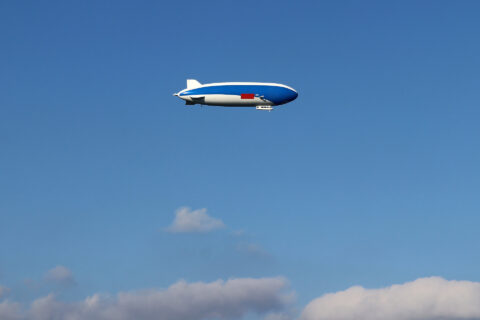FAU scientists researching sustainable alternatives to airplanes
FAU a major player in interdisciplinary research into airships
When people think of airships, they usually think of Zeppelins that were used between 1900 and 1940 for military purposes and for transporting people. At FAU, an interdisciplinary team of researchers is working on developing solar-powered airships. An international conference was held on the topic at the end of September at Energie Campus Nürnberg (EnCN). We spoke to Christoph Pflaum, professor of Computer Science, about modern airships.
What is a computer science professor doing studying airships?
My research focuses on computational engineering, that is the simulation and optimization of technical devices. I have always been interested in applications in the field of renewable energies. Modern airships fly with highly efficient solar cells and lightweight batteries. We calculate how many solar cells are required, how large the battery should be and how long it will take to transport a certain amount of goods. These are questions that relate to computational engineering.
What do modern airships look like and what are their advantages?
Nowadays, airships can be used as unmanned drones, both small ones that fly at low altitudes and high-altitude airships that fly at an altitude of approximately 20 kilometers. That apart, traditional airships can also be used to transport goods and people. When transporting people, a distinction is made between traditional airships and hybrid airships. Hybrid airships combine the properties of an airplane and an airship. One major advantage of these airships is that virtually no energy is needed to keep them in the air. This is the role of the lifting gas. Another advantage is the large surface of airships, which can be used for solar energy. This allows goods to be transported in a climate-friendly and economic way. It is also easier to reach remote locations in the event of natural disasters.
To what extent are airships a suitable alternative to airplanes in the fight against climate change?
Carbon-neutral air travel is not at all the same thing as climate-friendly air travel. Zero emission flights are important. The German Aerospace Center is now experimenting with using hydrogen or batteries to make electric flight possible. However, the technical requirements for using either of these methods for transporting goods and people in long-haul flights will not be able to be met in the foreseeable future. It is also unlikely to be economically viable on medium-haul flights. With airships, however, zero emission flights are easily possible. Using additional solar cells would make fuel costs negligible when compared to those incurred by airplanes.
Which challenges does your research face?
There is a lot to do, as in the last 90 years only very little research has been conducted into airships and if at all, then mainly by private investors. One idea that has been raised is to use a vacuum as a lifting gas, as helium is extremely expensive. Hydrogen would be cheap, but would require the development of new safety mechanisms. Research is currently being conducted into both areas, and we will discuss this during our conference. We will also discuss a number of other topics, such as efficient take-off and landing procedures irrespective of weather conditions, the optimization of airship routes, the global simulation of an airship flight, lightweight construction and the stable integration of solar cells into the outer shell of an airship.
Which opportunities does the EnCN offer FAU in this research?
FAU focuses on three major topics: lightweight construction of high-performance electronics, developing flexible, lightweight solar cells and the simulation and route optimization of airships. The Energie Campus is the central location for our research. It is the perfect place for the conference with international experts in Nuremberg, interestingly the only conference on airships this year. We are very proud of the interdisciplinary research we are conducting at FAU in collaboration with the Fraunhofer Institute for Integrated Systems and Device Technology, Prof. Martin März from the Chair of Power Electronics and Prof. Christoph J. Brabec from the Chair of Materials Science and Engineering.
Realistically, when will the first airships be launched?
Strictly speaking, high altitude airships are already available. The companies Avealto and Sceye have demonstrated that their airships can fly for months at an altitude of approximately 20 kilometers. The first manned solar airship was built several years ago in France. The first captain of a solar airship, Bastien Lefrancois, will naturally also attend our conference. The interesting question is when the first fully rigid airship fitted with solar cells will make its first flight. The company LTA Research from California is currently working on such an airship. It will be up to 180 meters in length, and will initially fly using electric batteries. It is unclear if and when airships such as these will be fitted with solar cells, or whether researchers will opt initially for the technically less complex option of hydrogen and fuel cells.
International airship conference from September 28 to 29
Together with his colleagues Prof. Christoph Brabec and Prof. Martin März, Prof. Pflaum is organizing the International Conference On Electric Airships – Decarbonizing Aviation. On September 28 and 29, experts from across the globe met to discuss the future of zero emission air travel.
Further information:
Prof. Dr. Christoph Pflaum
Professorship of Computer Science
